A Psychophysically Validated Metric for Bidirectional Texture Data Reduction

|
Abstract
|
Bidirectional Texture Functions (BTF) are commonly thought to provide the most realistic perceptual experience of materials from rendered images. The key to providing efficient compression of BTF is the decision as to how much of the data should be preserved. We use psychophysical experiments to show that this decision depends critically upon the material concerned. Furthermore, we develop a BTF derived metric that enables us to automatically set a material's compression parameters in such a way as to provide users with a predefined perceptual quality. We investigate the correlation of three different BTF metrics with psychophysically derived data. Eight materials were presented to eleven naive observers who were asked to judge the perceived quality of BTF renderings as the amount of preserved data was varied. The metric showing the highest correlation with the thresholds set by the observers was the mean variance of individual BTF images. This metric was then used to automatically determine the material-specific compression parameters used in a vector quantisation scheme. The results were successfully validated in an experiment with six additional materials and eighteen observers. We show that using the psychophysically reduced BTF data significantly improves performance of a PCA-based compression method. On average, we were able to increase the compression ratios, and decrease processing times, by a factor of four without any differences being perceived.
|
|
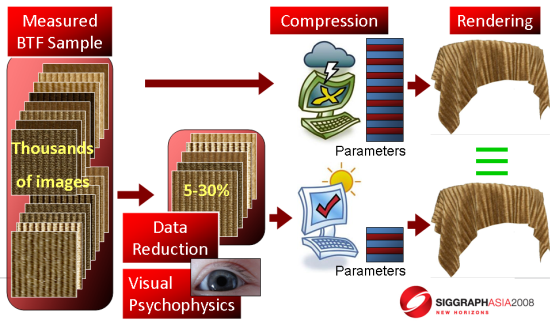
|
Keywords
|
Surface texture, BTF, texture perception, phychophysical experiment,
texture compression, perceptual metric.
|
Preprint Version of the Paper
|
© ACM, 2008. This is the author's version of the work. It is posted here by permission of ACM for your personal use. Not for redistribution.
The definitive version will be published in ACM Transactions on Graphics 27(5), December 2008, http://doi.acm.org.
|

 [preprint]
[preprint]
|
@article{filip08psychophysically,
author = {Filip, J. and Chantler, M.J. and Green, P.R. and Haindl, M.},
title = {A Psychophysically Validated Metric for Bidirectional Texture Data Reduction},
journal = {ACM Transactions on Graphics (Proceedings of SIGGRAPH Asia 2008)},
publisher = {ACM Press},
volume = {27},
number = {5},
year = {2008},
month = {December},
conference = {ACM SIGGRAPH Asia 2008},
pages = {},
url = {http://staff.utia.cas.cz/filip/projects/pertex} }
|
Supplemental Materials
|
© ACM, 2008. This is the author's version of the work. It is posted here by permission of ACM for your personal use. Not for redistribution.
The definitive version will be published in proceedings of ACM SIGGRAPH Asia 2008.
|

 [pdf]
[pdf]
 [video] (50MB, DivX or XviD codec needed)
[video] (50MB, DivX or XviD codec needed)

 slides with notes (12MB)
slides with notes (12MB)
|
BTF Reduction Results
Main experiment samples reduced using perceptually estimated thresholds.
|
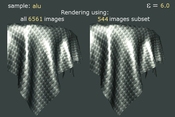
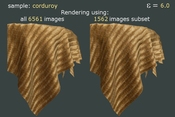
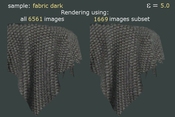
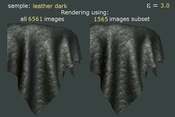
|
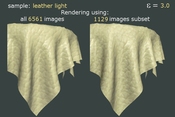
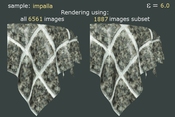
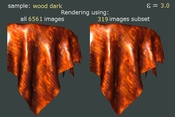
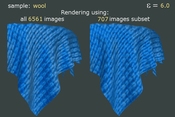
|
Validation experiment samples reduced using thresholds set automatically using the proposed metric scaled by the perceptual data of the main experiment.
|
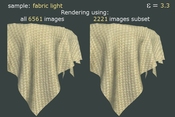
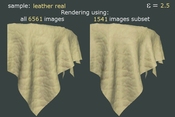
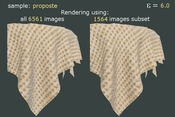
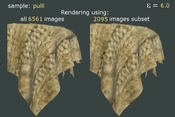
|
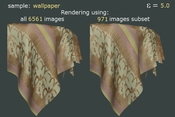
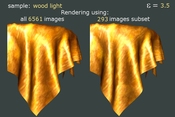
|
Acknowledgements
|
| J. Filip was supported by EC Marie Curie Intra-European Fellowship No.41358
(PerTex - Perceptual Analysis and Measurement of Surface Texture). |
| This research was also supported by EPSRI SMI grants GR/S12395, EP/F02553X/1,
GACR grant 102/08/0593, and 1ET400750407. |
We would like thank to:
|
| Bonn University for providing us with BTF measurements. |
| Vlastimil Havran for help with environment illumination. |
| Participants in the psychophysical experiments. |
| Anonymous reviewers for their helpful comments and suggestions. |
| Paul Debevec for grace and St.Peters lighting environment maps. |
| Stanford University for bunny 3D model. |
| Bootstrap-software for psignifit library.
|

|
|
Last update 09/09/2008
|






